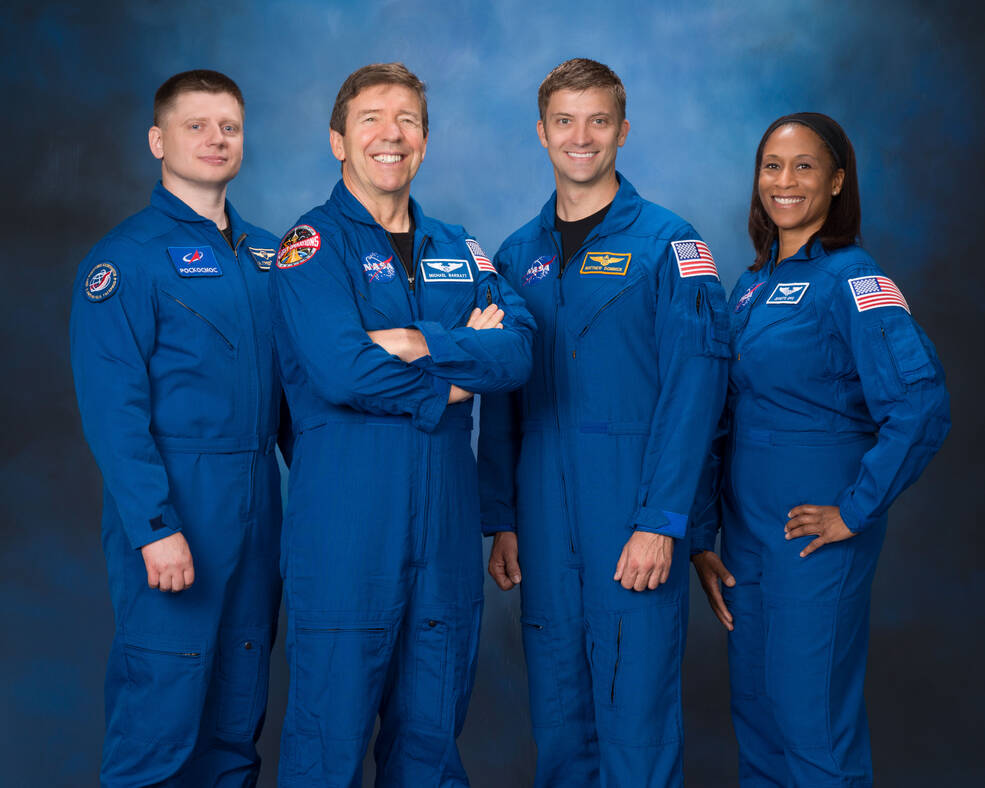Four crew members now are assigned to launch on NASA’s SpaceX Crew-8 mission for a long-duration stay aboard the International Space Station.
Four crew members now are assigned to launch on NASA’s SpaceX Crew-8 mission for a long-duration stay aboard the International Space Station.
NASA astronauts Commander Matthew Dominick, Pilot Michael Barratt, and Mission Specialist Jeanette Epps, along with Roscosmos cosmonaut Mission Specialist Alexander Grebenkin, will join Expedition 70 and 71 crew members aboard the station in early 2024 to conduct a wide-ranging set of operational and research activities.
This will be the first spaceflight for Dominick, who became a NASA astronaut in 2017. He is from Wheat Ridge, Colorado, and earned a bachelor’s degree in electrical engineering from the University of San Diego, California, and a master’s in systems engineering from the Naval Postgraduate School in Monterey, California. He is an active-duty U.S. Navy astronaut. He graduated from the U.S. Naval Test Pilot School in Patuxent River, Maryland, and then served as a test pilot specializing in testing landing on and catapult launches from U.S. Navy aircraft carriers.
This will be Barratt’s third trip to the space station. In 2009, Barratt served as a flight engineer for Expeditions 19 and 20 as the station transitioned its standard crew complement from three to six, and performed two spacewalks. He flew aboard the space shuttle Discovery in 2011 on STS-133, which delivered the Permanent Multipurpose Module and fourth Express Logistics Carrier. He has spent a total of 212 days in space. Born in Vancouver, Washington, he Considers Camas, Washington, to be his hometown. Barratt earned a bachelor’s in zoology from the University of Washington, Seattle, and a doctor of medicine from Northwestern University in Chicago, Illinois. He completed residencies in internal medicine at Northwestern and aerospace medicine along with a master’s degree at Wright State University in Dayton, Ohio. After nine years as a NASA flight surgeon and project physician, Barratt joined the astronaut corps in 2000.
This also will be Epps’ first trip to the space station. She is from Syracuse, New York, and earned a bachelor’s in physics from LeMoyne College in Syracuse, New York, and a master’s in science and a doctorate in aerospace engineering from the University of Maryland, College Park. Prior to joining NASA, she worked at Ford Motor Company and the Central Intelligence Agency. She was selected as an astronaut in July 2009, and has served on the Generic Joint Operation Panel working on space station crew efficiency, as a crew support astronaut for two expeditions, and as lead capsule communicator in the Mission Control Center at NASA’s Johnson Space Center in Houston. Epps previously was assigned to NASA’s Boeing Starliner-1 mission. NASA reassigned Epps to allow Boeing time to complete development of Starliner while also continuing plans for astronauts to gain spaceflight experience for future mission needs.
Grebenkin, who graduated from Irkutsk High Military Aviation School, Irkutsk, Russia, majoring in engineering, maintenance, and repair of aircraft radio navigation systems, also is flying on his first mission. He graduated from Moscow Technical University of Communications and Informatics with a degree in radio communications, broadcasting, and television.
This is the eighth rotational mission to the space station under NASA’s Commercial Crew Program, which works with the American aerospace industry to provide safe, reliable, and cost-effective transportation to and from the orbital outpost on American-made rockets and spacecraft launching from American soil.
For more than 22 years, humans have lived and worked continuously aboard the International Space Station, advancing scientific knowledge and demonstrating new technologies, making research breakthroughs not possible on Earth. As a global endeavor, 244 people from 19 countries have visited the unique microgravity laboratory that has hosted more than 3,000 research and educational investigations from researchers in 108 countries and areas.
The station is a critical testbed for NASA to understand and overcome the challenges of long-duration spaceflight and to expand commercial opportunities in low Earth orbit. As commercial companies focus on providing human space transportation services and destinations as part of a robust low Earth orbit economy, NASA is able to more fully focus its resources on deep space missions to the Moon and Mars.
Find more information on NASA’s Commercial Crew Program at:
https://www.nasa.gov/commercialcrew
-end-
Joshua Finch
Headquarters, Washington
202-358-1100
joshua.a.finch@nasa.gov
Courtney Beasley
Johnson Space Center, Houston
281-483-5111
courtney.m.beasley@nasa.gov



























